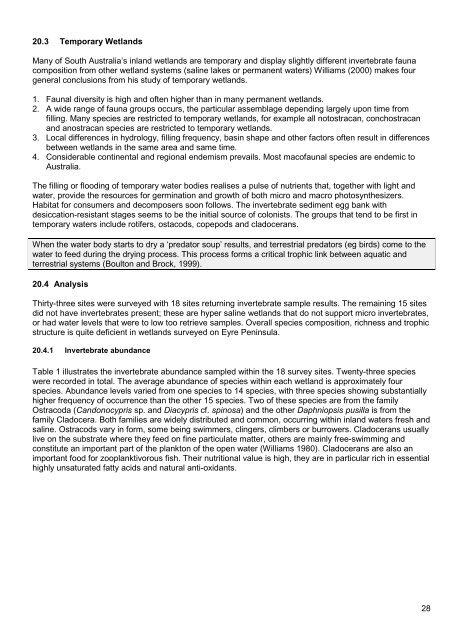2007 Wetland Inventory for the Eyre Peninsula
2007 Wetland Inventory for the Eyre Peninsula
2007 Wetland Inventory for the Eyre Peninsula
- No tags were found...
You also want an ePaper? Increase the reach of your titles
YUMPU automatically turns print PDFs into web optimized ePapers that Google loves.
20.3 Temporary <strong>Wetland</strong>sMany of South Australia’s inland wetlands are temporary and display slightly different invertebrate faunacomposition from o<strong>the</strong>r wetland systems (saline lakes or permanent waters) Williams (2000) makes fourgeneral conclusions from his study of temporary wetlands.1. Faunal diversity is high and often higher than in many permanent wetlands.2. A wide range of fauna groups occurs, <strong>the</strong> particular assemblage depending largely upon time fromfilling. Many species are restricted to temporary wetlands, <strong>for</strong> example all notostracan, conchostracanand anostracan species are restricted to temporary wetlands.3. Local differences in hydrology, filling frequency, basin shape and o<strong>the</strong>r factors often result in differencesbetween wetlands in <strong>the</strong> same area and same time.4. Considerable continental and regional endemism prevails. Most macofaunal species are endemic toAustralia.The filling or flooding of temporary water bodies realises a pulse of nutrients that, toge<strong>the</strong>r with light andwater, provide <strong>the</strong> resources <strong>for</strong> germination and growth of both micro and macro photosyn<strong>the</strong>sizers.Habitat <strong>for</strong> consumers and decomposers soon follows. The invertebrate sediment egg bank withdesiccation-resistant stages seems to be <strong>the</strong> initial source of colonists. The groups that tend to be first intemporary waters include rotifers, ostacods, copepods and cladocerans.When <strong>the</strong> water body starts to dry a ‘predator soup’ results, and terrestrial predators (eg birds) come to <strong>the</strong>water to feed during <strong>the</strong> drying process. This process <strong>for</strong>ms a critical trophic link between aquatic andterrestrial systems (Boulton and Brock, 1999).20.4 AnalysisThirty-three sites were surveyed with 18 sites returning invertebrate sample results. The remaining 15 sitesdid not have invertebrates present; <strong>the</strong>se are hyper saline wetlands that do not support micro invertebrates,or had water levels that were to low too retrieve samples. Overall species composition, richness and trophicstructure is quite deficient in wetlands surveyed on <strong>Eyre</strong> <strong>Peninsula</strong>.20.4.1 Invertebrate abundanceTable 1 illustrates <strong>the</strong> invertebrate abundance sampled within <strong>the</strong> 18 survey sites. Twenty-three specieswere recorded in total. The average abundance of species within each wetland is approximately fourspecies. Abundance levels varied from one species to 14 species, with three species showing substantiallyhigher frequency of occurrence than <strong>the</strong> o<strong>the</strong>r 15 species. Two of <strong>the</strong>se species are from <strong>the</strong> familyOstracoda (Candonocypris sp. and Diacypris cf. spinosa) and <strong>the</strong> o<strong>the</strong>r Daphniopsis pusilla is from <strong>the</strong>family Cladocera. Both families are widely distributed and common, occurring within inland waters fresh andsaline. Ostracods vary in <strong>for</strong>m, some being swimmers, clingers, climbers or burrowers. Cladocerans usuallylive on <strong>the</strong> substrate where <strong>the</strong>y feed on fine particulate matter, o<strong>the</strong>rs are mainly free-swimming andconstitute an important part of <strong>the</strong> plankton of <strong>the</strong> open water (Williams 1980). Cladocerans are also animportant food <strong>for</strong> zooplanktivorous fish. Their nutritional value is high, <strong>the</strong>y are in particular rich in essentialhighly unsaturated fatty acids and natural anti-oxidants.28
















